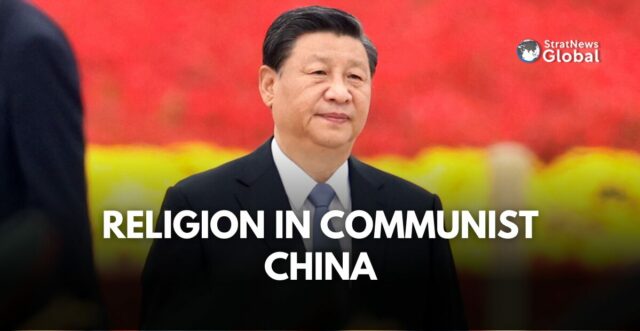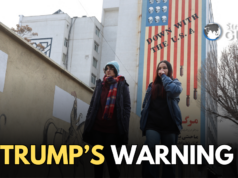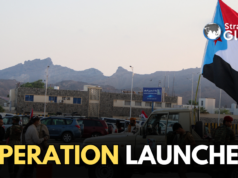Religion In China
China’s religious landscape is a complicated collage peppered with distrust, deceit, dubious intents and discouraging party politics. With the government officially recognising five religions—Buddhism, Taoism, Islam, Protestantism and Catholicism—and regulating them with an iron hand, much remains to be seen on how Chinese society grapples with faith or manages spiritual vacuums. Authorities tightly monitor registered and unregistered religious groups. In 2021, the U.S. Government estimated that Buddhists comprise 18.2% of the country’s population, Christians 5.1%, Muslims 1.8%, followers of folk religion 21.9% and atheists 52.2% with Hindus, Jews and Taoists comprising less than 1%. In a more accurate estimate, based on publications of the Council on Foreign Relations (May 15, 2024). The percentage of the population having religious affiliations in China is given below.

Members of the Chinese Communist Party (CCP) are officially banned from practising religion. While there is some leniency to folk practices; Christianity and Islam are considered foreign religions. The diktat to all religious institutions that they must uphold the leadership of the Chinese Communist Party, promote Xi Jinping thought and Sinicisation of religion, only affirms the acute political control desired by CCP over religion. There is a large and consolidated State effort to ensure religious groups are more aligned to Chinese culture, morality and diktats of the CCP.
Notwithstanding the clampdown measures, practising religion in China has been on the rise. China started with banning religious activities during the Cultural Revolution (1966-76), acknowledging people’s demand for religion (1980s), to revival of religious institutions and groups (1990s). While the Constitution does permit following of five accepted religions of Buddhism, Taoism, Islam, Protestantism and Catholicism; these are under strict State control. Apart from registration of religious organisations with State sanctioned patriotic religious associations, supervision by the United Front Work (a branch of the Communist Party) ensures due monitoring and regulation.
The Hammering Of Buddhism
Tibet has been long apportioned the unfortunate fate of being a strategic state in a dangerous neighbourhood at a momentous time in Asian history. The invasion of Tibet (termed “liberation of Tibet” by the Chinese) has profoundly and consistently impacted India-China relations, especially their boundary dispute, which is intrinsically linked to the Sino-Tibetan conflict. Moreover, the institution of the Dalai Lama continues to be the centrepiece of such India-Tibet-China geopolitical complexity. His Holiness the 14th Dalai Lama, Yeshe Tenzin Gyatso, is one of the most revered spiritual leaders of modern times. His Holiness is the present reincarnation of the previous 13 Dalai lamas of Tibet, who are in turn are considered to be manifestations of Avalokiteshvara, or Chenrezig, the Bodhisattva of Compassion, holder of the White Lotus. He is believed to be the 74th in a lineage that is traced back to a Brahmin boy who lived in the time of Buddha Shakyamuni. Born on 05 July 1935, in a small village of Taktser, located in the province of Amdo, he was named Lhamo Thondup, which literally meant ‘Wish Fulfilling Goddess’, his journey as the 14th Dalai Lama, started in 1939-40 where he forfeited his name and assumed the name of Yeshe Tenzin Gyatso. His education comprised teachings from the Nalanda traditions, with five major and five minor subjects including logic, fine arts, Sanskrit, Medicine and Buddhist philosophy which encompassed Prajnaparamita (the perfection of wisdom), Madhyamika (the philosophy of middle way), Vinaya (the canon of monastic discipline), Abidharma (metaphysics) and Pramana (logic and epistemology).
1950 saw raids and cross-border incursions by the Chinese into Tibet, threatening the region and robbing the Tibetans of the peace they practiced. In October 1950, reports of PLA crossing the Drichu River East of Chamdo with 80,000 soldiers deeply disturbed and threatened Tibet. In a bid to assign political authority over Tibet, His Holiness was officially enthroned the temporal leader of Tibet over six million people at the Norbulingka Palace on November 17, 1950 at the age of 15. With no assistance coming from the U.S. and the UK, the process of dialogue was initiated through the Governor of Kham to prevent the invasion of Tibet.
Eventually through coercion, the Chinese unilaterally announced that a 17 Point ‘Agreement on Peaceful Liberation of Tibet’ had been accepted on May 23, 1951, between Government of PRC and Local Government of Tibet, even to the extent of forging the Tibetan seal. From July 1954 to March 1957, His Holiness visited China and met Mao Zedong and Chou Enlai, Zhu Teh and Deng Xiaoping. Due to growing threats, increasing brutality against the Tibetans, repression of religion, and in a bid to have sustained existence of faith, on March 17, 1959, with the consultations of the Nechung Oracle, His Holiness travelled to India and crossed the Indian borders on March 31, 1959, and reached Bomdilla in Arunachal Pradesh.
At almost 90, His Holiness is the highest spiritual leader and head of Tibetan Buddhism. His succession has been fiercely debated as CPC has put enormous efforts to have complete influence over Buddhism through control over the legacy of Dalai Lama and institution of a CPC-nominated head. The question over the Dalai Lama’s reincarnation reflects the larger ideological and political debates about the Central Tibetan Administration (CTA) versus the Communist Party of China (CPC), religious freedom versus materialism, the sovereignty of Tibet versus China’s occupation of it, and history itself. New Delhi has over the prolonged political refuge of the Dalai Lama, maintained an ambiguous Tibet policy, primarily with an intent to not infuriate China. There is a case to merit, to refute Chinese claims of legitimacy over the succession of His Holiness and bringing to fore the impact of such a miscalculation which can further Buddhism into an unending abyss of misrepresentation.
Xi Jinping has legislated three core demands to the Dalai Lama: accepting Tibet as an inseparable part of China; abandoning Tibet Independence; stopping activities to split the Motherland; and has advised the Dalai Lama to ‘discard any illusion, face reality squarely, correct mistakes, and choose an objective rational path’. China fears that since the 6th Dalai Lama was born in Tawang in 1683, the 14th Dalai Lama, may plan to recognise a successor in Tawang, which makes His Holiness visits to the area highly sensitive and anxious for China. The situation has now often been referred to as the diplomatic grey zone. With limited signs of positive moderation by China over Tibet, rapid Sinicisation of religion, changing demographic overtones, China is set to nominate the successor of the 14th Dalai Lama, while India should prepare for the eventuality of actual successor of 14th Dalai Lama being nominated from India.
Compounded with this is also the striking case of the missing Panchen Lama. Being one of the most important leaders of Tibetan Buddhism, his detention since 1995 is one more significant religiously oppressive step adopted by the CPC. Gedhun Choekyi Nyima, the 11th Panchen Lama, was born in Chinese occupied Tibet on April 25, 1989. At the age of 6, he was recognised by the Dalai Lama as the reincarnation of the previous Panchen Lama. But three days after this recognition, Chinese authorities kidnapped the child and his parents. The Panchen Lama has not been seen since.
The Persecution Of Muslims
The Xinjiang Uyghur Autonomous Region, located in China’s northwest is the only region in China with a majority Muslim population. The Uyghurs, Kazakhs, Kyrgyz and other communities in this region are ethnically Turkic. As per the 2010 census, Uyghurs made up 46% and Kazakhs 7% of the Xinjiang population. The stories appearing on millions being detained in detention camps, subjected to indoctrination in political education camps, pre-trial detention centres and prisons have all received due coverage in the media. Mass surveillance, arbitrary arrests, forced sterilisations, enforced disappearances and religious erasure are common practices instituted by the State that continue unabated. The Chinese Government calls these detention centres as ‘vocational education and training centres’. International media organisations and researchers call these re-education camps, internment camps and detention camps. The detainees are targeted for various reasons, including contact with other Islamic nations, visiting mosques, having more than three children, sending texts and Quranic verses or being extremists.
The entire process of persecuting the Muslims is multi-faceted and systemic. The overarching reasons show that Chinese believe that ethnic minority population threatens social stability and national identity, with violations of birth limits. Xinjiang has been claimed by China since the CCP took power in 1949. Chinese Party officials view the Islamic community as extremist and separatist with threat to China’s territorial integrity, government and population. The CCP has since instituted measures to shape all religions to adhere to the Han-Chinese customs, which relate to the atheist party beliefs including passage of an anti-extremism law that prohibits growing long beards and wearing veils in public. The parents are also prohibited from naming their children Mohammed and Medina. The reasons for such absurdities in managing religion stem also from the need to ensure the safety of the ambitious BRI that passes through this region.
Xinjiang is also the region with the largest coal and natural gas reserves in China. Hence, resource extractions without separatist overtones are desirable to ensure there is no unrest. Since 2017, it has also been assessed that Xinjiang’s birth rate has declined by 84%. China, however, denies any religious, humanitarian or human rights violations.
The Last Word
There is a much larger need for the world to see religious colonisation being orchestrated by the Chinese in a bid to safeguard the interests of the Party. This legacy of Xi Jinping, will leave a distorted interpretation of religion, selfishly directed by the CPC, whose members are prohibited to practise any form of religion. There is a need for a united call for adherence norms as far as religion is governed, with the international community pitching in ensuring social rights. India’s policy on Tibet and the fateful succession of 14th Dalai Lama needs serious review to contextualize the fate of India-China relations.
Research Associate at StratNewsGlobal, A keen observer of #China and Foreign Affairs. Writer, Weibo Trends, Analyst.
Twitter: @resham_sng





